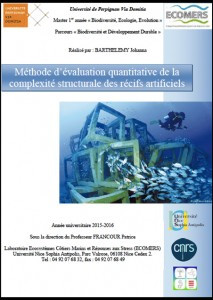
Method for quantitative evaluation of the structural complexity of artificial reefs
Events
Master 1 internship report co-signed by the AMPN on the structural assessment of artificial reefs:
The latest review published on artificial reefs in France (Tessier & al., 2015) emphasizes that the structural complexity or three-dimensional complexity strongly influences the colonization of artificial reefs and their effectiveness as a new habitat for mobile animal species (fish, crustaceans especially).
However, as these authors point out, the evaluation of the complexity of artificial reefs has never before been carried out in a quantitative and standardized way. According to the various semi-quantitative methods employed to assess the complexity of the habitat, there are at least six recognized elements of complexity which are: the variety of size of the refuge cavities (Roberts & Ormond, 1987), the roughness of the substrate (Risk, 1972; Roberts & Ormond, 1987; Jennings & al., 1996; Ohman & Rajasuriya, 1998), substrate heterogeneity (Ohman & Rajasuriya, 1998), habitat height (Luckhurst & Luckhurst , 1978; Molles, 1978), the arrangement of structural elements (Tokeshi & Arakaki, 2011) and the volume of cavities occupied (Ruitton & al., 1999).
The objective of this study is to propose a method for the quantitative evaluation of the structural complexity of artificial reefs, it is therefore appropriate to consider the six recognized elements of habitat complexity and to develop indices independent of the size/area of considered habitats. The six components of complexity identified in the scientific literature have therefore been translated into an index based on simple ideas and on classic ecological concepts in order to be able to quantitatively assess the complexity of a habitat, artificial reef or natural habitat. To validate this set of indices, it would then be necessary to test them in the field, scuba diving, on a wide range of habitats.
